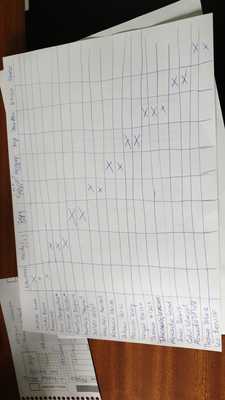Below a description of how the collaborations were carried out.
pages and subpages : Vocabulary
goal: learn or review the vocabulary of numbers and calculations
To review vocabulary learnt the year before, FR-17 students make a paper folding game, which supports some questions to review the vocabulary. These paper games are sent per post to Spain.
ES students play these games. They design other questions for practicing vocabulary and embed those in some kahoot games.
To learn the vocabulary, FR-16 students play the kahoot games from Spain. They enjoy it very much. Each of them designs new calculations presented in a magazine article. This task is very challenging for them.
To use this vocabulary by learning the structure of algorithms prior to computer programming, ES students design algorithms for calculating one's birthday.
FR-17 students perform the ES algorithms and return the ES students' date of birth.
pages and subpages: The Monty Hall Problem
goal: a paradox in a game show proved by probabilities
FR-18 and ES students watch the same video presenting a TV show game which was popular in the 1960s in the US, The Monty Hall TV show.
ES students perform the game many times, by simulating digitally, to collect results into statistic datas. They use statistics to decide which option is most favourable to the player to chose. They share their statistics results on the twinspace.
Each FR-18 student explains the math proof in a magazine article and in a video, where he/she explains the final answer given by ES students from their insight of statistics
pages and subpages: Fractals
goal: learn sequences in a life situation and solve a paradox
FR-18 students draw a famous fractal called the "Koch Snow Flake" showing a paradox betwen perimeter and area of a closed curve. They calculate with sequences to solve the paradox.
ES students share a famous fractal called the "Sierpinski triangle". They share the drawing algorithm to obtain this diagram.
FR-18 and ES students share their understanding of these two examples for one problem by writing e-magazine articles and by making videos.
FR-18 students discover the Sierpinski triangle through the ES contributions. They read the article and they follow their drawing guidelines given in videos to obtain the diagram on software geometry geogebra.
ES students discover the Koch Snow Flake by reading the FR-18 contributions.
pages and subpages: Magic and mathematics
goal: several magick tricks that are proved with arithmetic and algebra equations
FR-17 students perform some magic tricks and prove them with maths. They share these by writing magazines articles and making videos.
ES students send in return another trick, that was solved in class in France.
page: Secret messages
goal: students learn the principles of cryptography, the science of writing/sending coded messages with a secret key on one hand, of breaking a stolen coded message by a spy without the secret key.
The twinspace page shows the messages shared by FR-17 and ES students. They used the twinspace mailbox to send their secret key to their partner.
Students needed to be paired into transnational teams for this activity. ES teacher Inma matches the students, on the photo, FR-17 names vertically, ES names horizontally.

pages and subpages: Geometry Algorithms
goal: learn and use the vocabulary for geometry.
FR-16 students learn the vocabulary specific to geometry.
They design drawing instructions to obtain a final drawing. By publishing their instructions only on the page, ES students follow these instructions to find out the planned drawing. Their answers were embeded in a twinboard. Doing so, students chose themselves their partner in the peerwork.
These twinspace pages have been copied into the e-magazine.
page: Dissemination/Ersmus Days
goal: promote in students ' mind the opportunities offered by the Erasmus and eTwinning programs.
ES students joined the FR celebration through video conferencing.